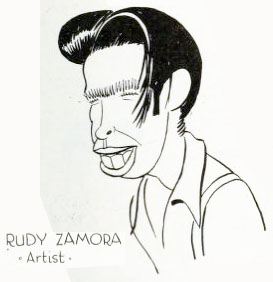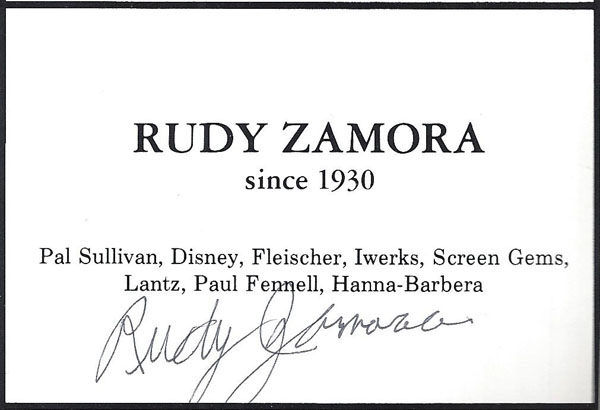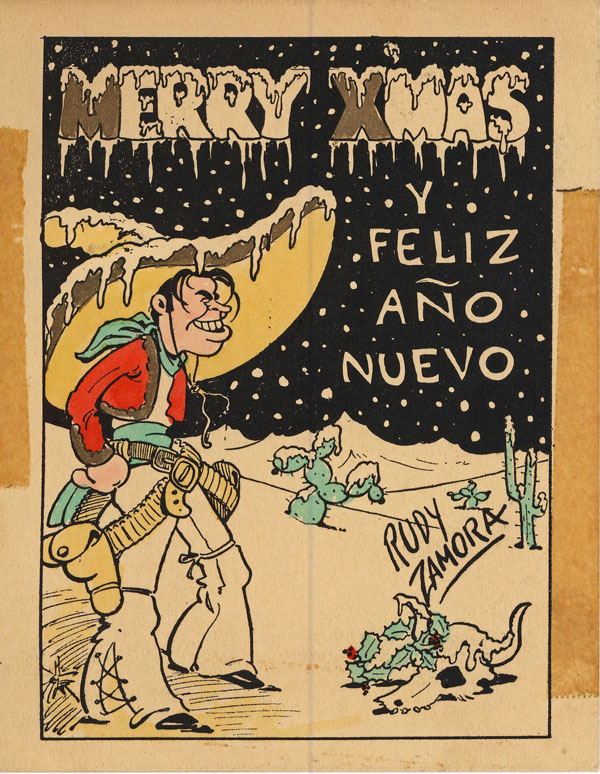
There is surprisingly little written about legendary animator Joaquin Rudolfo Zamora; most of what is out there generally refer to his colorful personality exemplified by a number of anecdotes relating to his short temper and no nonsense sensibilities, which either got him fired, or resulting in him quitting a job in anger.
To Shamus Culhane, Rudy was “the star of the ‘New Wave’ animators” at Fleischer Studios in the early 1930s. He was a prolific animator whose speed did not seem to take away from the very high quality of his work. (In the early days, animators were sometimes valued more for their speed more than for their abilities.) A big bear of a man, he was beloved by his colleagues, a sentiment clearly evident in the extra intensity of applause when his name was announced at the first Golden Awards Banquet in 1984.

Caricature by Jack King – from 1931 Motion Picture Herald – via Babbitblog
Born in Mexico City in 1910, his father moved his family to the States when he was four years old, finally settling in Pennsylvania’s Alleghany Valley, before coming to New York at 15. After high school, he went to Cooper Union for a year before launching his career as an artist. One job involved doing lettering for catalogs, which he found frustrating as he “wanted to do heads and hands” instead (an obvious step up from lettering). He complained that his work was “too mechanical” which got him into a fight with his boss, who called him “lazy.” Zamora recalled that, “I got mad and threw keys at him and a little piece of blood came out, and he [chased] me [with a] metal T-square; he threw it and almost hit me with the damn thing, and I just ran. Wow! I wouldn’t tell my folks what had happened, that this job this friend of my dad’s got me. I couldn’t tell him.”
Not only that, he found himself in Central Park with not even enough money to buy a newspaper to check the want ads, so he was forced to scrounge for one. He saw an ad that said: “‘Young man interested in animation.” Whatever animation is, I don’t know, but to me it sounded interesting.” This brought him to the Pat Sullivan Studio, where he was given a test tracing Felix the Cat. Zamora came in second to an African-American, with Eddie Salter third. He recalled that, animator Dana Parker “took the black boy [aside] and told him that they’ll call him when they needed him, [as they were] not hiring anyone that day. But they kept Eddie and I. That was lousy. Then they would have hired this black guy and myself. Ed was third.” When Zamora complained about this to Parker, he was told, “The old man didn’t want any black guys.”
Eventually, after what he saw as a meager pay raise, he talked himself into a much higher salary at Fleischer’s, where he became an inbetweener, eventually working under Dick Huemer and Sid Marcus. He recalled, “I enjoyed Marcus for a couple of reasons. He was funny with his drawings, and above all I loved his timing. What a combination! A damn good animator, and a good draftsman, and a funny guy, and then good timing. Those were all the essentials in animation. So I worked for those two until they both left the studio.”
It was their departure, along with George Stallings and George Rufle, which gave Zamora and several other inbetweeners a chance to be animators. (This was at a time when the studio did not have assistant animators.) As a result, Zamora took over animation of The Glow-Worm (1930) from Huemer. Culhane later wrote, “The result was incredible; there was no way to tell where Huemer had ended and Zamora had taken up.”
Zamora then collaborated with Culhane on several films, including In My Merry Oldsmobile (1931), before leaving for the West Coast, where he worked for Disney (a clip from the 1931 Silly Symphony The China Plate, above left), Iwerks, Screen Gems, Lantz, MGM, Bill Melendez, DePatie Freleng, Paul Fennell and Hanna-Barbera, plus a stint in Detroit at industrial filmmaker Jam Handy, where he again worked with Max Fleischer. Along the way, he became involved in the early activities of the Screen Cartoonists Guild.
For more information and insight on Zamora, I strongly suggest checking out Shamus Culhane’s invaluable memoir, Talking Animals and Other People, now out of print, and Gene Deitch’s brief recollection of working with him at Jam Handy here.


Fleischer-era Christmas Card by Rudy Zamora – via Virginia Mahoney and the Seymour Kneitel blog
NEXT WEEK: Two for the Holiday week: Tom Baron and… (check back next week to find out)


 Harvey Deneroff is an independent film and animation historian based in Los Angeles specializing in labor history. The founder and past president of the Society for Animation Studies, he was also the first editor of Animation Magazine and AWN.com. Harvey also blogs at deneroff.com/blog.
Harvey Deneroff is an independent film and animation historian based in Los Angeles specializing in labor history. The founder and past president of the Society for Animation Studies, he was also the first editor of Animation Magazine and AWN.com. Harvey also blogs at deneroff.com/blog.




































































As a Latino myself it’s great to see “one of my own” being recognized! Thanks Harvey for the great article on a great talent.
Hi Harvey,
Fantastic post! Zamora’s godson George Cannata Jr. told me Zamora immigrated to the US illegally and never got citizenship despite living the rest of his life here. Did you ever hear anything like that? Apparently Cannata sr. used to kid him about it all the time.
And that story about the african american boy being turned down at Sullivan’s is heartbreaking. Sullivan sounded like a truly horrible person, from every account I’ve ever heard.
Honestly, my hatred of Pat Sullivan just increased reading that story. It also makes me wonder about the racial attitudes of most people in the animation biz at that time. I understand Disney hired a black animator in the 1950s but I wonder if it would have been impossible for a black artist to find work in the animation field in the 20s and 30s?
Paul Terry employed many minorities as artists, and Howard Beckerman told me he was under the impression that Terry would’ve employed a black artist “had one ever come along”.
I had the same reaction when I read Borge Ring’s comments about David Hand on Michael Barrier’s web site. All my respect for the guy evaporated in an instant. Here’s the quote:
“Hand was by upbringing an old-fashioned traditional racist. “We got a letter from an art teacher in New Orleans, He sent us artwork done by one of his best students.The guy was good, came to California and surprised us by being coal black. So we had to give him a test he couldn’t pass.” He had expected us to laugh here and our critical responses baffled him and made him angry. ”You crazy guys wouldn’t let a German soldiers into your home even though they are much closer to you than any black person.” We squirmed and protested. A question about Dave Fleischer’s particular properties as a director was answered by a snide antisemitic remark.”
Yes, at that time it pretty much depended on the attitudes of the employer and business culture.
Hello again Harvey..another great post.
It should be noted that Rudy was also a director during the first season of ROCKY AND HIS FRIENDS ( Rocky and Bullwinkle) in 1059. Here is video link https://www.youtube.com/watch?v=MzSrRr_A1vs
Merry Christmas
While I realize you, of course, meant 1959, somehow I like your typo better. Makes me wonder what Scott & Ward would have done a few years later with the Bayeux Tapestry.
This is a fantastic post, and I only wish I could read my copy of Shamus Culhane’s book to hear about working with Rudy Zamora. Sad that some people of color were ignored, and I’m glad that Rudy was out there to set the record straight. I will check out the links mentioned in the article for further background on the man.
Great stuff! It’s fascinating to see and hear video footage of these animation artists of long ago… “pure gold” indeed! I’ve enjoyed the accompanying posts as well. Thanks, Harvey, Jerry, and everyone else involved with unearthing and presenting these videos. I look forward to more!